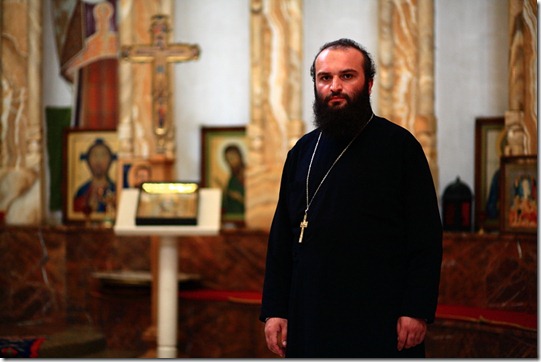A few days ago an anthropologist friend of mine told me that one of the reasons for the recent popularity of Orthodox Church in Georgia could be nation’s search for its own identity. That is, in this globalizing world Georgians are trying to set a niche for themselves, and this distinctive feature could be exactly Orthodoxy (in my friend’s opinion, for more than a century such a feature for Georgians was “supra,” or a feast table. The Orthodoxy substituting, or complementing, the tradition of supra as a part of nation’s self identification sounds rather interesting, doesn’t it? But this is a separate topic for a discussion and a research).
 Father Mathew of rock-cut cave monastery of Vardzia. Georgia, 2009
Father Mathew of rock-cut cave monastery of Vardzia. Georgia, 2009
Anyway, despite of its inducing factor, the Orthodoxy has definitely gained its foot in Georgia. New churches has been and are being built around the country and more people regularly attend religious services. Orthodox priests have started playing rather big role in society’s life. That’s especially true for the rural areas, where it’s extremely common for believers to go to priests for everyday advice or confession. However the role of priesthood is also noticeable in cities as well. Some Georgian Orthodox Christians treat priests of all levels as doubtless authorities, thus never putting their words under question.
 Father Moses at Holy Trinity Cathedral. Tbilisi, Georgia, 2009.
Father Moses at Holy Trinity Cathedral. Tbilisi, Georgia, 2009.
However, while one part of the Georgian society treats Orthodox priests as spiritual leaders, others, mostly rated as an intellectual and liberal elite, often accuse them of being nationalistic and intolerant to even being agents of Russian Federal Security Service (also known as FSB). While for some Orthodox priests (mistakenly called by many mamao, the vocative case of mama – father) these accusations might sound very valid, there are also those, whose main goal is to serve, help and educate their congregation.

Father Maxim in front of the 40-meter-high natural rock pillar. He says he wants to live and conduct services in the church he recently reconstructed on the top of the pillar, like so-called stylites did centuries ago. However, he hasn’t got permission from Patriarch to do so yet. Georgia, 2010.
So, here are some portraits of Orthodox priests I photographed in a previous couple of years.
 A priest prays at one of Tbilisi’s churches, which is in somewhat confrontation with the Georgian Patriarchy. Tbilisi, 2009
A priest prays at one of Tbilisi’s churches, which is in somewhat confrontation with the Georgian Patriarchy. Tbilisi, 2009
![IMG_9895[4] IMG_9895[4]](https://temophoto.files.wordpress.com/2010/09/img_98954_thumb.jpg?w=541&h=362) Archbishop Isaia of Nikozi church, located right next to the administrative boundary line between Georgia and South Ossetian. Having himself educational background in animation, archbishop Isaia has organized children’s computer animated cartooning club at his monastery. Nikozi, Georgia, 2010.
Archbishop Isaia of Nikozi church, located right next to the administrative boundary line between Georgia and South Ossetian. Having himself educational background in animation, archbishop Isaia has organized children’s computer animated cartooning club at his monastery. Nikozi, Georgia, 2010.
 Father David at the protest action in front of the embassy of Vatican in Tbilisi. Many Georgian Orthodox priests and some civic organizations associated with them protest against activities of Catholic Church, as well as of other confessions and religions, in Georgia. Georgia, 2009
Father David at the protest action in front of the embassy of Vatican in Tbilisi. Many Georgian Orthodox priests and some civic organizations associated with them protest against activities of Catholic Church, as well as of other confessions and religions, in Georgia. Georgia, 2009
 A priest blesses Georgian soldiers going to Afghanistan. Georgia, 2010
A priest blesses Georgian soldiers going to Afghanistan. Georgia, 2010
Very interesting subject. Is there a swarm of young converts to Orthodoxy then?
The picture of Archbishop Isaia is especially intriguing- with the light hitting him and the educational materials with the same slant.
Actually yes, Orthodoxy is quite popular nowadays among young people, it’s just that they’re not recent converts, in Georgia many parents baptize their children when the latter are very young (1-2 years old). As for the portrait of archbishop Isaia, yes, I like it the most and, plus to this, he seemed to be the most interesting and open minded Georgian Orthodox priest I’ve met by far.
Thanks for your comment. I read your blog as well, and find it very interesting.